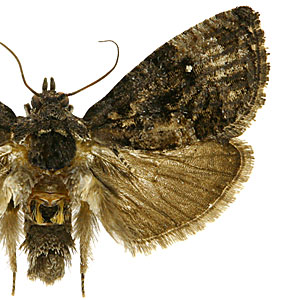Adult Recognition

FWL: 8.0-12.0 mm
Adults are brown to blackish gray with indistinct markings. A conspicuous white dot is present on the distal one-third of the forewing. Male genitalia are characterized by a short row of ca. 25-30 deciduous cornuti in the vesica. Female genitalia are characterized by a cestum in the ductus bursae that is closer to the ductus seminalis than the ostium. Males have distinctive sex scaling on the dorsal surface of the abdomen.
Males can be separated from those of Gymnandrosoma aurantianum by sex scaling on the dorsal surface of the abdomen and differences in genitalia. Two other species of Gymnandrosoma, G. linaresensis and G. cryptotortanum, have similar scale structures on the abdomen, but these species only occur in Mexico.
Larval Morphology

Although not described, larvae are assumed to be similar to other species in the Cryptophlebia-Ecdytolopha group, with an enlarged L-pinaculum on the prothorax that extends beneath (and usually beyond) the spiracle.
Biology

Little is known regarding the life cycle of this species. Collection records suggest multiple generations per year. In the midwestern U.S., adults are present in May through September. In Florida and southern locations, adults may be present year-round.
Host plants
Larvae of Gymnandrosoma punctidiscanum have been recorded feeding on locust and red oak.
| Family | Genus/species | Common name |
| Fabaceae | Robinia L. | locust |
| Fagaceae | Quercus rubra L. | red oak |
Distribution

Gymnandrosoma punctidiscanum is distributed from Massachusetts and southern Ontario west to Wisconsin and south to Florida and Texas.
References

Adamski, D. and J. W. Brown. 2001. Systematic revision of the Ecdytolopha group of genera (Lepidoptera: Tortricidae: Grapholitini) in the New World. Entomologica Scandinavica Supplement 58. 86 pp.
Gilligan, T. M., D. J. Wright and L. D. Gibson. 2008. Olethreutine moths of the midwestern United States, an identification guide. Ohio Biological Survey, Columbus, Ohio. 334 pp.


